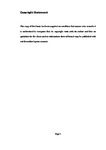Analysis and Correction of Corneal Astigmatism in Modern Pseudophakia
| dc.contributor.supervisor | Buckhurst, Phillip James | |
| dc.contributor.author | Hamer, Catriona Ann | |
| dc.contributor.other | Faculty of Health | en_US |
| dc.date.accessioned | 2016-05-05T11:31:06Z | |
| dc.date.available | 2016-05-05T11:31:06Z | |
| dc.date.issued | 2016 | |
| dc.identifier | 10422888 | en_US |
| dc.identifier.uri | http://hdl.handle.net/10026.1/4578 | |
| dc.description.abstract |
Toric intraocular lenses (IOLs) are designed to reduce spectacle dependency by correcting corneal astigmatism at the time of surgery. However, these IOLs are reliant on the accurate prediction of post-operative corneal astigmatism through reliable ocular biometry and the accurate calculation of surgically induced astigmatism. In the thesis the repeatability of assessing corneal curvature was assessed using six commercially available keratometers. The results question the validity of corneal biometry and infer that much of the apparent change in corneal shape usually associated with surgically induced astigmatism may be due to measurement error. The use of the oblique cross cylinder formulae for the calculation of post-operative corneal curvature was also investigated. This formula is incorporated into all commercially available toric IOL calculators and is utilised in every toric IOL implantation. The results from this thesis indicate that the formula is not applicable to the human cornea and that the use of the calculator does not increase the effectivity of the toric correction. Furthermore, the thesis queries the assumption that post-operative corneal astigmatism is directly proportional to post-operative refractive error. The disparity between both the magnitude and axis of astigmatism measured by keratometry and manifest refraction in a pseudophakic population was investigated. The axis measurements in particular showed very poor agreement; far outside an acceptable level of misalignment, significantly decreasing the effective correction provided if the lens was aligned with the keratometry readings. Inclusion of the posterior corneal curvature and thickness, along with a smaller chord length may lead to a more accurate assessment of corneal power. Despite the difficulty in providing an effective toric IOL correction, it was found that the correction of corneal astigmatism at the time of cataract surgery might decrease the risks of falls. Uncorrected astigmatism and cataract both cause a reduction in stability when stepping oven an obstacle, which is one of the most common causes of trips and falls in the elderly population. | en_US |
| dc.description.sponsorship | Plymouth University | en_US |
| dc.language.iso | en | en_US |
| dc.publisher | Plymouth University | en_US |
| dc.subject | Cataract Surgery | en_US |
| dc.subject | Keratometry | en_US |
| dc.subject | Vision and Mobility | en_US |
| dc.subject | Astigmatism | en_US |
| dc.subject | Pseudophakia | en_US |
| dc.title | Analysis and Correction of Corneal Astigmatism in Modern Pseudophakia | en_US |
| dc.type | Thesis | |
| plymouth.version | Full version | en_US |
| dc.identifier.doi | http://dx.doi.org/10.24382/3198 | |
| dc.identifier.doi | http://dx.doi.org/10.24382/3198 |
Files in this item
This item appears in the following Collection(s)
-
01 Research Theses Main Collection
Research Theses Main


